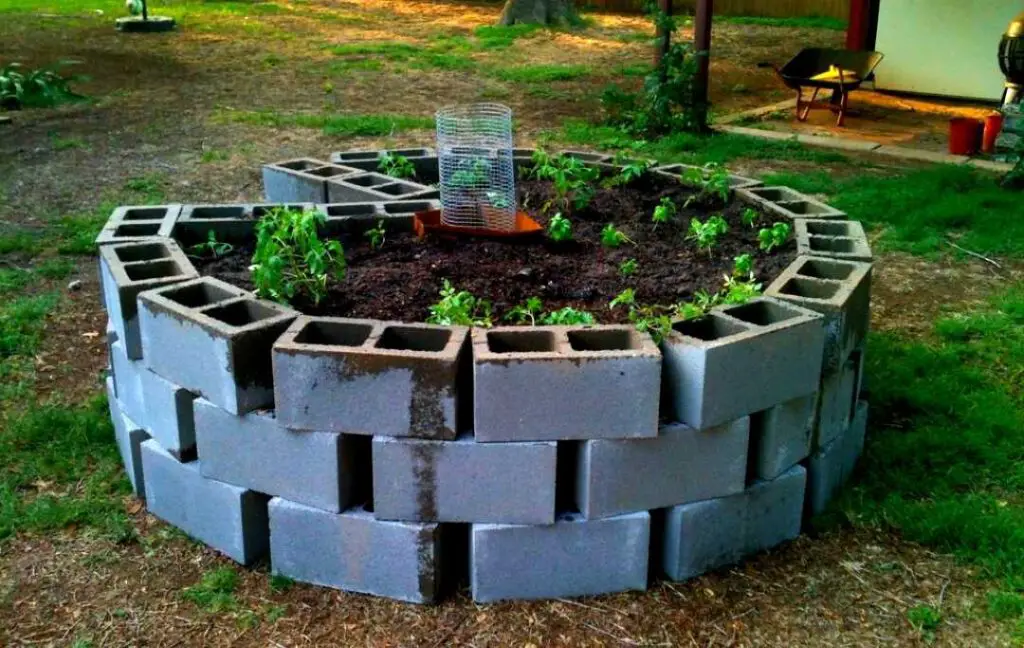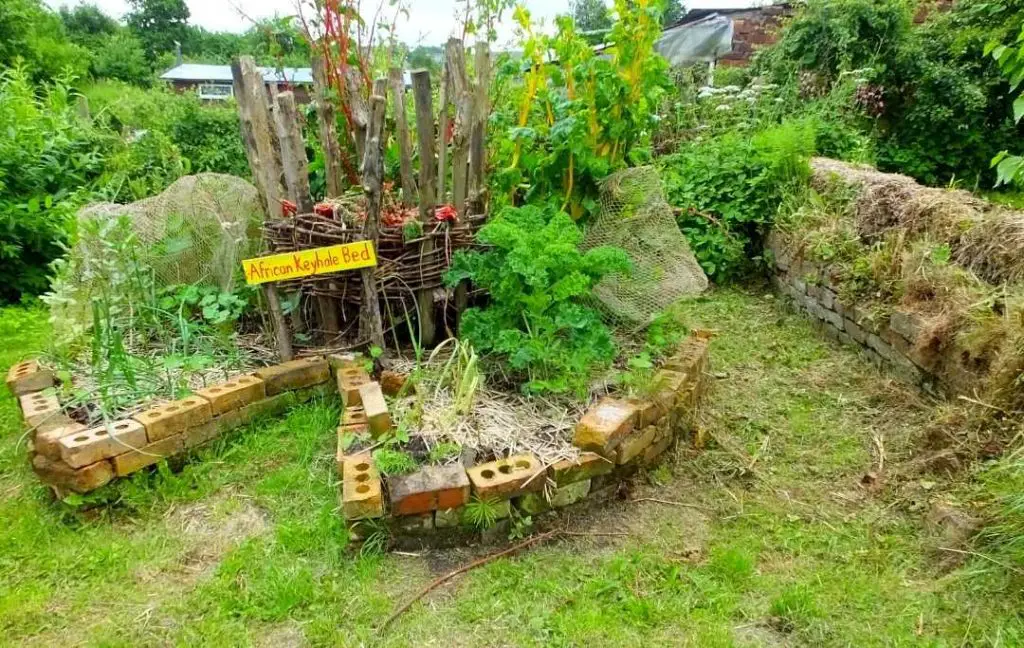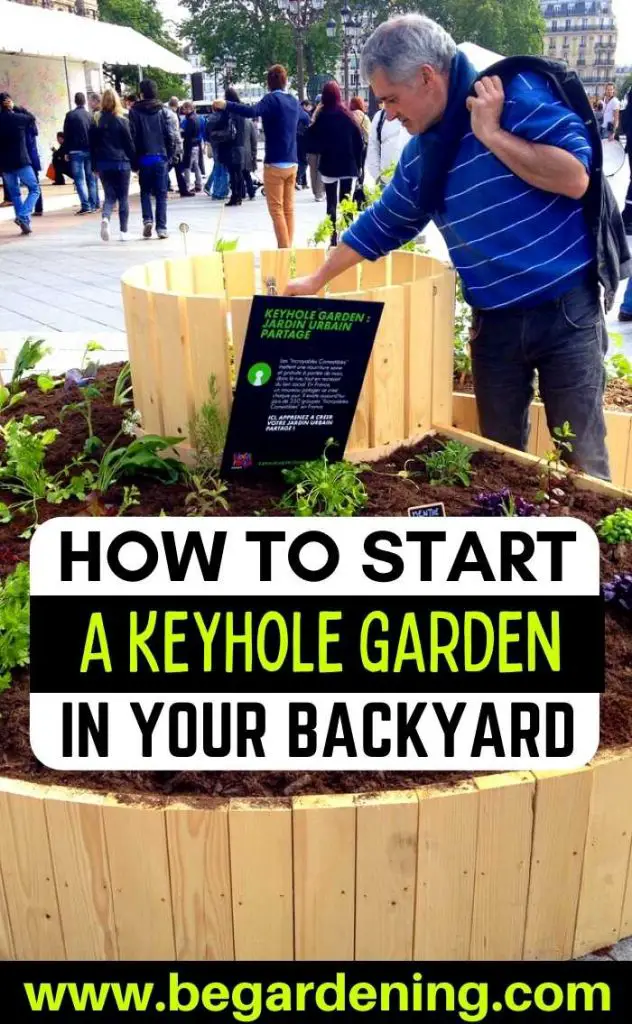A keyhole garden is a circular raised bed. You grow crops in the outer circle and the center portion has a composting basket. Due to the old-fashioned skeleton-keyhole shape, it has been given this name.
You throw kitchen scrapes and grey-water into the compost basket daily. This will help to recharge the soil to encourage development in the plants.

The soil in the Keyhole Garden is layered to maintain moisture and nourishment. The organic materials which are used by the soil are available at no cost.
Benefits Of The Keyhole Garden
It is a circular raised garden bed that has a wedge-shaped cutout. You can easily access the center of the bed due to its extraordinary shape. At the center of the bed, you will find a cage that serves as a compost pile.
This basket or cage is filled with kitchen waste which decomposes over time and releases all the essential nutrients in the soil. Following are the advantages of a keyhole garden.
1- MAKE YOUR SOIL RICH
The biggest benefit of the keyhole garden is that it makes the soil rich for your plants. With time, the layers of organic materials break down and provide all the basic nutrients to the soil.
The soil of the keyhole garden bed will replenish continuously. As a result, your plants get all the required organic materials for their growth.
2- KEEP YOUR SOIL MOIST
Moist soil is very important for your plants and the layer of organic materials helps to retain moisture. It means that your keyhole garden needs less water than a conventional garden.
If you are living in such an area where you are facing a shortage of water then you should follow the technique of keyhole gardening.
3- SAVE YOUR TIME AND NEED LITTLE HARD WORK
The other benefit of keyhole gardening is that it will save your time. Nourishment and moisture retention properties will make it perfect for those gardeners who have busy schedules.
If you are facing any physical issues or you are too old then you can easily access your plants due to elevated walls of keyhole garden beds. In gardening, you have to do a lot of work that’s why you will suffer from physical pain.
A keyhole garden bed will save you from these problems because there is no need for bending and heavy digging.
4- LOW-COST DESIGN
There is no need of spending a lot of money on constructing this garden bed. All the material is available in your garden.
5-YEAR-ROUND VEGETABLE PRODUCTION
In keyhole gardening, you use stones that will absorb the heat of the sun. They retain heat so your crops will be protected from cold winter. You can start your growing season earlier if you grow your plants in a keyhole garden. So you will get a long growing season as the soil of raised beds warm up quicker.
6- CRITTER FREE AREA
A keyhole garden bed is an elevated bed so it keeps away pests from your plants. Raised beds are the best way of avoiding pests. It is not possible when you grow plants on the grounds.
How Does A Keyhole Raised Bed Work?
When you examine the keyhole garden then you will come to know what is going on inside the keyhole raised bed. There are four main parts of a keyhole garden and each part is performing its role very perfectly.
- As the layer which is made from rocks and twigs will perform the best function of drainage.
- The brown and green organic materials layer which you add to the compost basket will rot over time.
- The layer which is consists of topsoil will be used for growing vegetables.
- You will also see a well of compost where you can add kitchen waste and greywater. Greywater is water which is previously used for household purposes.
There is a notch at the center of the raised bed that makes its shape just like a keyhole. This notch is very important as it helps to reach the central compost and inner parts of the keyhole raised bed.
Read More
What’s Special About The Keyhole Garden Design?
All the layers of organic matter of the keyhole raised bed works together to retain the moisture in the soil. So there is no need for regular water during the growing season.
When time passed, these organic layers rot and feed the soil. Your plants get all the basic nutrients from the soil and as a result, the production of vegetables will be increased.
The compost well which is the important part of the keyhole garden provides a one-stop location for your kitchen waste. Your plants will get full advantage of kitchen scrapes.
You can say that a keyhole garden is a low-maintenance raised bed that provides high nutrients to your plants. This is an inexpensive and reasonable way of growing plants at home.
This is the reason it is related to permaculture gardening. It is a sustainable and regenerative way of gardening where your plants get water and nutrients from the soil.
There is no need for commercial fertilizers because the soil is rich in high nutrients. It means you can grow more plants than in a traditional garden.
Where To Put Your Raised Keyhole Garden?
The location is very important for any raised bed. First, you should think carefully about the area where you want to start your garden bed. The vegetables and other plants need 6 hours of sunlight daily so before choosing the location you should be careful.
If you are planning to grow leafy vegetables such as spinach or and lettuce then you can choose a shady area to keep your crop cool.
The ground where you are going to build a keyhole garden bed should be level and not subject to flooding. Your backyard is perfect for building this bed because this design will not add beauty to your growing area.
How To Make A Keyhole Garden Step By Step

This is very inexpensive bad and you need very less material for building it. You can make this keyhole garden bed with scrap materials. This bed takes several hours to build. The materials you need for building your keyhole garden bed are as follow:
- Sharpened stake
- String line for making your bed
- Drainage material
- Retaining wall material
- Chicken wire or hardware cloth
- Mulching material
- Topsoil
Step 1: Clear And Level Your Space
If the area which you select has some bumps and dips then you should adjust them. Keep in your mind that too much elevation is very difficult to handle. If you try to build a keyhole garden bed in such an area then it will be tricky.
Step 2: Mark Out Your Garden’s Footprint
Fix the steak in the middle of the bed. After that attach 3 or 4 feet long string to it. This will be the radius of your circular bed. Now pull the string taut and walk around the stake.
Mark out the circumference of your area. The 6-foot diameter of the circle is perfect for a circular bed. This marked outline help to build the wall.
Step 3: Place Your Compost Basket Or Well In The Center
You can use chicken wire or hardware cloth for creating a tabular compost basket. The diameter of the compost bin should be 1 foot. The composting basket should be 1 foot taller than the keyhole walls.
Step 4: Build Your Retaining Wall
Whatever material is available you can build the structure of the retaining wall. You can use concrete blocks, stake stones, rocks, bricks, pieces of corrugated metal, and wood.
Whatever material you will use in constructing the wall, the wall should be sturdy. The retaining wall should be stable enough to hold the weight of the soil.
Step 5: Add The Notch Or Keyhole
When the construction of the wall is completed then you can remove a two-foot section of the wall. at the center off, the wall extends it and narrows towards the compost well to create a notch.
Notch the circle just like cutting a wedge of pie. This will help you to access the center of your bed. With the help of the notch,h you can look after your plants very well.
Step 6: Add Drainage Where Needed
Spread a thin layer of drainage material at the bottom of the circular bed. In the layer, you can include gravel and twigs. If you are using well-drained soil then you can skip this step.
Step 7: Fill The Bed With The Layers Of Organic Matter
Brown and green composting materials add at this stage. You can use shredded leaves, grass clippings, straws, and old newspapers for this purpose.
Step 8: Top With Garden Soil
The depth of this layer should be 8 inches. The layer of the soil should be sloped towards the walls of the keyhole bed.
Step 9: Fill Your Compost Pile
This is a very important step. Fill the compost basket or well with compost and soak it with water.
Step 10: Plant Your Seeds, Flowers, Starter Plants
Make sure you sow the seeds according to the season. It is suggested that you should grow only for varieties of plants so they will be protected from the invasion of a particular pest. There should be a 50 cm gap between each row of the plants.
When winter season comes you should cover the soil with an old carpet to protect it from cold at night. In the day you should uncover the garden so it will absorb sunlight it and energy. When you see the seeds are germinated then in that case you should also uncover the raised bed.
In the root crops, you can grow carrots, onions, radish, beetroot, turnips, and garlic. In leafy crops, you can grow lettuce, spinach. swiss chard, mustard spinach, and herbs.
The root crops which are not suitable for growing in keyhole gardens are tomatoes, Chillies, papers, peace, and potatoes. The leaf crops which you can’t grow in keyhole gardens are eggplant, maize, cabbage, beans, and squash.

Keyhole Gardening Tips
In a keyhole garden bed, the plants get nutrients for years to come. There is no need of adding anything else for nutrients because your kitchen waste doing the job of delivering all the vital nutrients through the compost well.
The layers which are present beneath the surface of topsoil decompose the kitchen waste and help to retain the moisture.
Following are some useful tips that help you a lot in building your keyhole garden bed.
- When you fill your compost well of the keyhole raised bed then make sure the level of the well should be equal with your bed. Water the circular raised bed by pouring water into the well. Water will mix in the compost and carries all the nutrients to the soil.
- If you want to stop the growth of the weeds then you can add a layer of mulch on the top of the soil. This will help to stop the seeds of the beets from reaching the soil. Mulch also maintains the moisture level in the soil.
- Don’t grow the deep-rooted plants in the first year as their roots can not get the required amount of nutrients. With time, the organic matter will decompose and you can grow deep-rooted crops.
- Every year rotate your crops because plants carry pests and different diseases.
- Don’t choose the location of the keyhole raised bed near the large trees. The roots of the large trees will spread in the ground and they may steal the nutrients and moisture from the soil which is not good for your plants.
Read More
